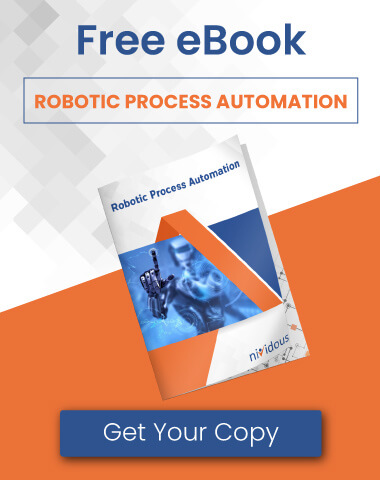Businesses around the world are investing in automation. In one 2020 survey, 66% of organizations said they were scaling the strategy across departments, fully automating one or more processes, or piloting the technology in at least one area. Companies that are late to the game may fall behind. The question, then, isn’t whether you should automate; it’s where to start.
Robotic Process Automation (RPA) is ideal for automating discrete tasks—moving data or managing documents, for instance. Artificial Intelligence (AI) can make RPA more powerful. But many companies gain the most benefit from automating entire processes, not just each step along the way. This requires workflow automation. It’s a key component of an end-to-end hyperautomation system, which automates not just individual tasks but the entire process, tackling complexity with AI. This may be your ultimate goal, but you can’t get there without addressing workflow. Here’s what you need to know about workflow automation—including how to begin.
Need to build a business case for workflow automation?
Start by estimating your Return on Investment with the Nividous RoI Calculator.
Workflow Automation: A Definition
To understand workflow automation, we can break it down into its component parts. Here’s Merriam-Webster’s definition of workflow: “the sequence of steps involved in moving from the beginning to the end of a working process.” The same dictionary says automation is “the technique of making an apparatus, a process, or a system operate automatically.”
Add a technology element to these explanations for a clear definition of workflow automation in a business context: Workflow automation is the application of digital technologies to manage—and often complete—steps in a business process from start to finish.
If you’ve read about hyperautomation or intelligent automation, this definition may sound familiar. There is a difference, but it’s a subtle one. Workflow automation emphasizes the business process management (BPM) component of any end-to-end automation system. It directs the process, not the task—and you may or may not incorporate task automation. Unlike intelligent automation, however, workflow automation does not necessarily use artificial intelligence. Rules-based systems can achieve many of the technology’s goals.
In short, workflow automation is about more than automating individual tasks. Processes include multiple steps, by definition. Humans or RPA bots may perform those tasks. Workflow automation software manages those employees and bots to streamline any process, step by step—with some powerful benefits.
The Benefits Of Workflow Automation
When you automate workflow management, you spend less time handling process minutiae. Instead, you can build rules into the system to create unique work queues, assign tasks to one employee or the next, orchestrate human workers and RPA bots, and track data at every step. In addition to freeing time for work that adds more value, workflow automation gives you the following advantages:
- Native data collection reduces manual errors and improves accuracy.
- Task management systems are available 24/7, boosting overall productivity.
- Data tracking and reporting improve compliance in regulated industries.
- Detailed reporting—including both business data and process data—provides insights for ongoing optimization.
- Clear and accessible workflows speed up employee onboarding and reduce reliance on individual expertise.
- Business tools are centralized into a single-pane-of-glass experience with one user interface.
Implement workflow automation to achieve these benefits and more. It might be easier than you think. Here’s a step-by-step guide for getting started.
How To Incorporate Workflow Automation Into Your Business
You can’t automate a workflow with a spreadsheet or a notepad. First, you need the right tool: workflow management software. The Nividous platform is a full-service workflow automation solution, providing everything you need to automate both individual tasks and end-to-end processes. With access to a digital automation system like the Nividous platform, you can take these steps to achieve effective workflow automation.
1. Choose a first process to automate.
Automation is itself a step-by-step operation; you can’t go from zero to full automation across your whole organization at once. Nividous consultants can help. We start every engagement with a deep dive into your day-to-day operation, categorizing each of your processes in terms of two key attributes: Value and Complexity.
High-value processes are those that boost the bottom line; they contribute heavily to your company’s mission. Processes with high complexity involve a lot of moving parts and many decision points. In order to generate the fastest return on investment in automation, look for processes that are high in value and low in complexity. That’s where you’ll generate the quickest Return On Investment (ROI).
Our emphasis is on broad-spectrum digital transformation, but you have to start somewhere. The reality of business decision-making is that you can’t proceed without stakeholder buy-in. That starts with a demonstration of value; in other words, an outstanding ROI. By ranking business processes on a Complexity Vs. Value Matrix and starting where automation provides the biggest return, we make sure your first workflow automation won’t be your last.
2. Build the automation.
This sounds simpler than it is, but compared to a typical IT project, it’s a cinch. Without a dedicated automation platform, your only option is to code back-end integrations and support systems into your business software array; that can take months or even years, and it’s expensive. A platform like Nividous provides workflow automation right out of the box, and you can get started in just a few weeks.
Once you’ve identified a first workflow to automate, Nividous works with your team to train RPA bots. Those handle task automation, but for full workflow automation, you also need a workforce orchestration dashboard, available in the Nividous Control Center. Here’s where the system manages your workflow. You can assign RPA bots to certain tasks and humans to others (see sidebar), and track the process as it unfolds, with real-time data reporting and analysis native to the platform.
Manual Tasks Within Workflow AutomationThe orchestration of human workers and RPA bots brings up an interesting question: If people are doing some of the work, can we really call this automation? Yes. To understand why, we should return to a key distinction in digital automation: You can automate a discrete task, like copying form data into an ERP. That’s accomplished best by RPA. But you can also automate process management itself, which is where workflows come into play. The Nividous platform does both, automating tasks and overall processes in a single system. It also tracks each step as it’s being completed, whether by an RPA bot or a human employee. Without automation, a human manager (or managers) must watch the process, create task queues for employees, and record completion along the way. Workflow automation takes over the job, freeing your management team to focus on innovation. |
3. Measure, adjust, and repeat.
The Nividous platform doesn’t just automate tasks, processes, and workflow orchestration; it also collects data every step of the way. Use that information to make continual improvements, both to system implementations and your process map. With Nividous, you’re not on your own in this effort. We offer ongoing support and maintenance to optimize workflow automations for the full length of deployment.
Your first workflow automation project serves as proof of concept. To continue your digital transformation journey, look back to the ranked list of processes you created in Step 1 of this list. Now that you know how it works, you can expand workflow automation on a continual basis. For instance, if you started by automating your invoicing process, you might next invest in marketing workflow automation—the journey continues.
Nividous offers assistance here, too. Our services team will help you set up your own internal Center of Excellence (CoE) to expand automation, establish best practices, and keep your business growing. We can help you build the infrastructure, access the necessary tools, train your workforce, and measure the ROI of automation as a long-term goal.
Real-World Examples Of Workflow Automation
Workflow automation will give you the edge in any industry, but in some, it’s becoming a prerequisite for growth. These are heavily regulated industries, such as finance, health care, and insurance. The native data collection in the Nividous platform allows these companies to remain compliant and handle audits with maximum information and minimum outlay. Whether you operate in a regulated industry or not, these examples of workflow automation can help you imagine how this solution could benefit your business.
1. A major insurer used workflow automation to save on underwriting costs.
A life and general insurer serving more than one million customers had an inefficient underwriting process. Workflow automation with the Nividous platform created a clear process map through a single web-based interface. The platform’s BPM component offered a streamlined process, complete with task tracking and participant notifications. It also improved underwriting with clear business rules that reduced reliance on human underwriters (among other automations). This workflow automation cut manual work by half and improved visibility across systems by 80%. Read the case study for details.
2. A manufacturer automated invoicing workflows to cut turnaround time nearly in half.
Invoice management involves multiple employees and lots of document swapping, making it an ideal candidate for workflow automation—as one leading mineral processor discovered. The company struggled with hundreds of invoices from multiple vendors, each passing through several layers of approval. The Nividous platform automated invoicing workflow, orchestrating both human workers and RPA bots with AI capabilities to extract data from invoices in a variety of formats. The solution led to a 90% reduction in invoice turnaround, eliminated manual errors, and saved more than 1,000 staff-hours per month. Read the case study to learn more.
3. A large banking system disbursed more loans faster with enterprise workflow automation.
Manual loan disbursement processes were slowing down a bank that already catered to more than 1.4 million customers. The bank used IBM BPM systems but hadn’t optimized its loan workflow—until Nividous stepped in to help. The team worked with the bank’s business and IT departments to create a centralized workflow system that tracked and orchestrated every task in the process, including handheld devices for data collection in the field. With the new automated workflow, this bank sped up loan disbursement considerably, leading to a 20% increase in loan volume, improved communication with customers, and a reduction in turnaround time of nearly 80%. Read the case study for more information.
Workflow Automation On The Nividous Platform
As these examples illustrate, workflow and automation go hand in hand. Start realizing the benefits of workflow automation today with the Nividous platform. Nividous provides end-to-end process automation out of the box and can automate discrete tasks with RPA, complex jobs with AI, and complete workflows with BPM. Altogether, this adds up to intelligent automation—and you control it all through a single easy-to-use interface.
Ready to see it for yourself?
Contact us for a free, personalized demo of the Nividous workflow automation platform.





